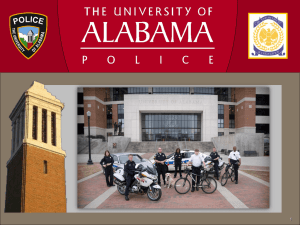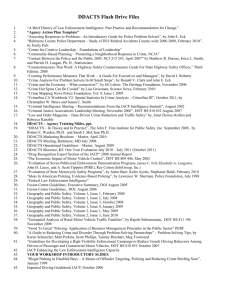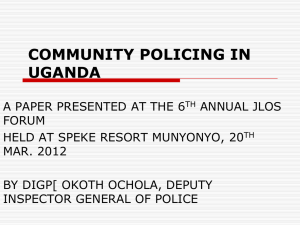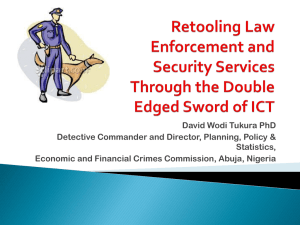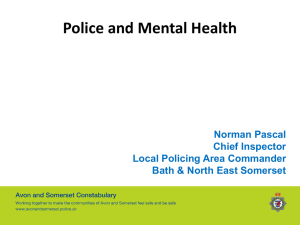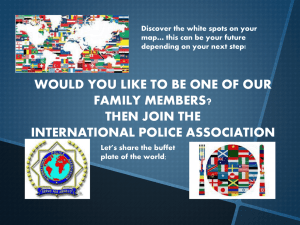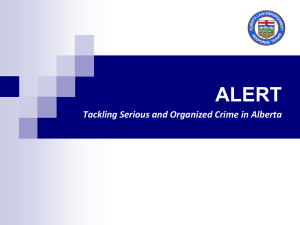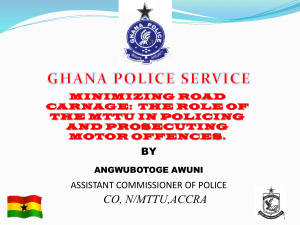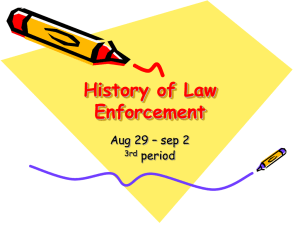community policing initiatives that involve law - LEO
advertisement
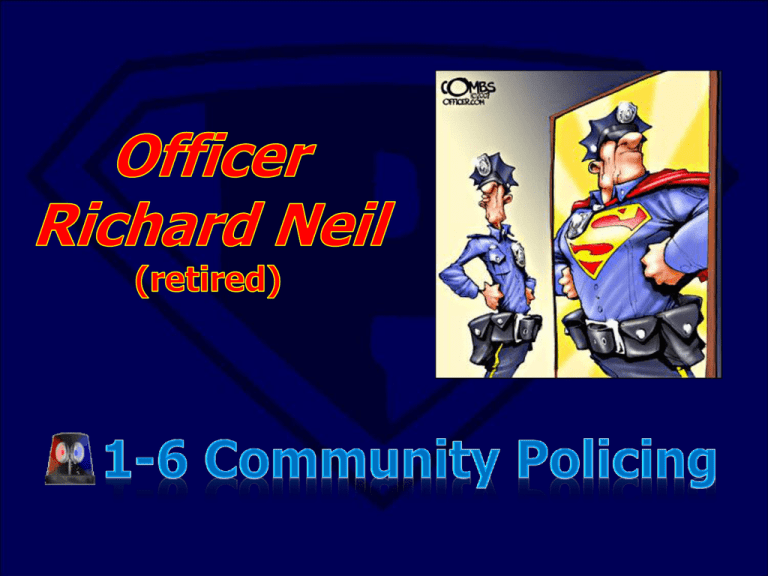
Crime Prevention The Development of American Law Enforcement The United States has more police departments than any other nation in the world. Virtually every community has its own police force, creating a great disparity in the quality of American police personnel and service. American Police History 1626, the New York City Sheriff's Office was founded 1631, the Town of Boston started its first "Night Watch“ 1838, first local modern police department established in the United States was the Boston Police Department Police were not respected by the community, as corruption was rampant Who were the first Police Officers? Bass Reeves Born enslaved in 1838 in Crawford County, Arkansas Fled north into Indian Territory and lived with Seminole and Creek Indians. Reeves and his family farmed until 1875 Recruited by Judge Isaac Parker & U.S. Marshal James Fagan in 1875 Reeves arrested over 3,000 fugitives & killed at least 14 At statehood became a member of the Muskogee, Oklahoma, police department at the age of 68 State Police Agencies Growing populations, as well as the inability of some local sheriffs and constables to control crime, led states to create their own law enforcement agencies. Texas officially created the Rangers in 1835. Pennsylvania established the first modern state law enforcement agency in 1905. By the 1930s, every state had some form of state law enforcement agency. The evolution of policing 1920s, led by Berkeley, California police chief, August Vollmer, police began to professionalize, adopt new technologies, and place emphasis on training First female police officer was Alice Stebbins Wells, who was hired by the Los Angeles Police Department in 1910 LAPD also hired the first African-American police officer, Georgia Ann Robinson, in 1916 Professionalism and Reform • Until the late 19th century, there were no qualifications required for law enforcement officers. • Cincinnati was the first city to require (2) qualifications of police officers: – High moral character – Foot speed The Structure of American Law Enforcement American law enforcement agencies are extremely diverse in: Jurisdictions Responsibilities Employers (hospitals, colleges, transit authorities may have their own police) COMMUNITY POLICING DEFINED A PRACTICAL, EFFECTIVE WAY OF POLICING THAT HELPS LAW ENFORCEMENT AND COMMUNITY PARTNERS WORK TOGETHER TO IDENTIFY CRIME AND ITS RELATED PROBLEMS, THEN DEVELOP WAYS TO RESOLVE AND PREVENT CRIME AND DISORDER FROM OCCURRING IN THE FUTURE 1. 2. 3. 4. 5. 6. 7. 8. 9. 10. PHILOSOPHY CHANGE COMMITMENT FUTURISTIC PERSONALIZED ENFORCEMENT PROACTIVE SPECIAL NEEDS TRUST GRASS ROOTS TEN PRINCIPLES OF COMMUNITY POLICING THREE ESSENTIAL ELEMENTS OF COMMUNITY POLICING PARTNERSHIPS EMPOWERMENT PROBLEM SOLVING MISSION STATEMENTS DESCRIBE THE PURPOSE OF AN AGENCY YOU SHOULD KNOW THE MISSION STATEMENT FOR ANY AGENCY YOU INTERVIEW WITH The role of the law enforcement agency in Community Policing Management THE PROCESS OF PLANNING, ORGANIZING, LEADING AND CONTROLLING THE WORK OF ORGANIZATION MEMBERS TO REACH STATED ORGANIZATIONAL GOALS Leadership: The process of directing and influencing the task-related activities of organization members Leadership is doing the right things and involves inspiring a shared set of values and vision for the future Community Policing cannot be mandated from on high; leaders in the agency must lead by example Building Consensus Communication is a two way process Seek ownership from all stakeholders in the Community Policing process, including…WHO??? EMPOWERMENT Agencies must empower or give official power and authority to law enforcement personnel as they implement community policing in the community Empowerment recognizes that the people who actually do the job are in a position to know how to do the job in the best way EMPOWERMENT RESULTS IN: MORE PHILOSOPHICAL BUYIN A GREATER SENSE OF OWNERSHIP IN THE PROCESS INCREASED PRODUCTIVITY EFFECTIVENESS OF SERVICES FOR THE COMMUNITY DUTIES OF THE OFFICER IN COMMUNITY POLICING ENFORCE LAWS & FOLLOW THEM PROBLEM SOLVING INCREASE POSITIVE COMMUNITY INVOLVEMENT WITH LAW ENFORCEMENT RECRUIT AND SUPERVISE COMMUNITY VOLUNTEERS COMMUNICATION BETWEEN LAW ENFORCEMENT AGENCY AND COMMUNITY Continued REFERRALS TO OTHER AGENCIES NETWORK WITH OTHER AGENCIES, INCLUDING THE PRIVATE SECTOR Full service policing: Adding a new dimension to law enforcement Daily interaction with “customers” (citizens) Crime prevention and the enforcement of laws The officer must ascertain when each is appropriate, a broker of law enforcement and related services and a facilitator between the community and service providers Shaping the new policing role Creative problem solving skills Ability to distinguish between symptoms of crime and actual crime problems Interpersonal communication skills including public speaking Outside activities and interests including volunteer opportunities CREATIVE THINKING IS DEFINED AS 1ST STEP IN PROBLEM SOLVING CREATIVITY IS AN ATTITUDE CREATIVITY DOES NOT ACCEPT THE OBVIOUS CREATIVITY ASKS WHY AND QUESTIONS THE STATUS QUO CREATIVITY HAS MULTIPLE PERSPECTIVES AND LEARNS BY LISTENING TO THOSE WHO ARE OR MAY BE DIFFERENT ATTRIBUTES OF CREATIVE THINKERS INTELLIGENT FLEXIBLE INTELLECTUALLY PLAYFUL POSITIVE NONCONFORMITY APPROPRIATELY PERSISTENT SELF-CONFIDENT AWARE OF SELF AND OTHERS THE FOUR STEPS OF PROBLEM SOLVING ARE: SCANNING ANALYSIS RESPONSE ASSESSMENT Problem Solving Incidents are usually a symptom of a larger problem Traditionally, police have been conditioned to treat symptoms or handle an incident as an isolated event rather than identify and address problems COMMUNITY POLICING INITIATIVES THAT INVOLVE LAW ENFORCEMENT AND THE COMMUNITY-CRIME PREVENTION NEIGHBORHOOD WATCH CITIZEN POLICE ACADEMIES WHAT PREVENTS CREATIVE THINKING FALSE PRIDE FAILURE TO FULLY DEFINE A PROBLEM CONTENTMENT WITH THE PROBLEM/STATUS QUO SINGLE SOLUTION THINKING A PROBLEM IS DEFINED AS: TWO OR MORE INCIDENTS SIMILAR TO EACH OTHER THAT CAUSE HARM TO THE PUBLIC AND THAT THE PUBLIC EXPECTS LAW ENFORCEMENT TO HANDLE Scanning Discovering and identifying the problem Most important of the four steps Avoid confusing symptoms with the real problem Learn about and verify the problem Identify the problem in terms of the people involved, their behavior and response to the problem Analysis Understand the actors, actions and reactions to the problem Determine each aspect of the problem Gather information including: The seriousness of the problem The individuals and groups affected by the problem The possible causes of the problem Solution objectives Response The action or solution decided on to address the identified problem Solutions may eliminate the problem Reduce the frequency of incidents Reduce harm to the community Improve the community’s perception of the problem Response Response objectives recognize that the strategy to address the problem must go beyond the incident to address: Underlying issues Provide a long-term solution Improve the community in some way Ultimately reduce police workload by reducing or eliminating the problem Assessment Determines whether the selected response was carried out as planned and effectively addressed the identified problem Assessment is essential to determine the effectiveness of the response If the response strategy was ineffective, go through the S.A.R.A. process again After a third attempt, involve outside individuals to study the problem Word Association SCOUT LEADER The Problem Trust does NOT save lives. Distrust saves police officers every day. Normal Threat Level Hypervigilance Alert, alive, energetic, humor Normal Threat Level Hypervigilance Normal Threat Level Tired, detached, isolated, apathy Easy to think the problem is your home life. Everyone gets Screwed! • • • • Who controls what kind of cop you will be? You only control your integrity and professionalism. Department controls assignments, schedules, and duties. You control your personal life. Keep it that way! Victim Attitude • • • • Leads to integrity issues Leads to entitlement problems Lose sense of self Cops will justify and rationalize behavior that they normally wouldn’t participate in. Things to Do Aerobic Exercise* Time Management Keep a Personal Life Remember that your career WILL end someday


